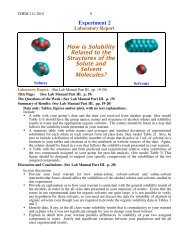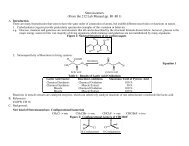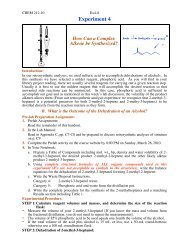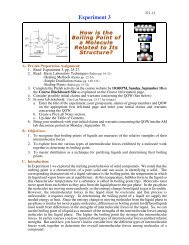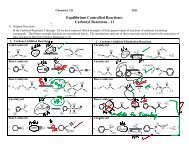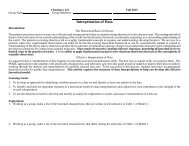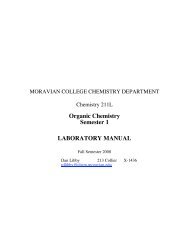Organic Chemistry Semester 1 LABORATORY MANUAL - Moravian ...
Organic Chemistry Semester 1 LABORATORY MANUAL - Moravian ...
Organic Chemistry Semester 1 LABORATORY MANUAL - Moravian ...
Create successful ePaper yourself
Turn your PDF publications into a flip-book with our unique Google optimized e-Paper software.
Part V. Techniques and Theory Appendix C1 Infrared Spectroscopy<br />
Appendix C. Infrared Spectroscopy:<br />
See also See Padías pp. 64 – 74 and CGWW pp. 65-72<br />
Source of the IR Spectrum<br />
Vibrational Energy Levels<br />
Covalent bonds link atoms together to form molecules. Though these bonds have normal<br />
average lengths, the relative positions of the atoms are constantly changing due to bond<br />
vibrations. A bond can be thought of as a spring with atoms attached to each end.<br />
A<br />
B<br />
bending<br />
stretching<br />
bond<br />
stretching<br />
As with other types of molecular changes, bond vibrations occur only at certain frequencies<br />
(ν) and each of these ν's is associated with a vibrational energy level of energy = hν. Thus, each<br />
bond has a series of vibrational energy levels.<br />
Transitions<br />
When electromagnetic radiation (light) is shone upon a molecule, one of its bonds can absorb a<br />
quantum of the energy and pass from a lower vibrational energy level to a higher one if the<br />
radiation contains light of a proper frequency (ν).<br />
e.g.<br />
light (! 1 )<br />
E 3<br />
!E o -> 2<br />
E = h! 1<br />
E 2<br />
E 1<br />
The Spectrum:<br />
" !E 0 -> 2 = h! 1<br />
E 0<br />
IR absorption bands are measured as a function of the ν of the incident light. The units of ν are<br />
cm -1 .<br />
Note: Since E = hν for light, the energy of absorbed light is proportional to ν, that is, the energy<br />
of the photons of light increase as their ν's increase.



